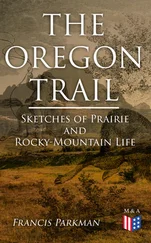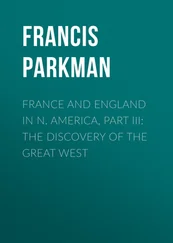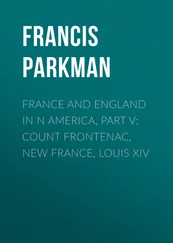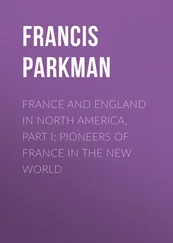Francis Parkman - A Half-Century of Conflict - Volume II
Здесь есть возможность читать онлайн «Francis Parkman - A Half-Century of Conflict - Volume II» — ознакомительный отрывок электронной книги совершенно бесплатно, а после прочтения отрывка купить полную версию. В некоторых случаях можно слушать аудио, скачать через торрент в формате fb2 и присутствует краткое содержание. Жанр: foreign_prose, История, foreign_edu, foreign_antique, на английском языке. Описание произведения, (предисловие) а так же отзывы посетителей доступны на портале библиотеки ЛибКат.
- Название:A Half-Century of Conflict - Volume II
- Автор:
- Жанр:
- Год:неизвестен
- ISBN:нет данных
- Рейтинг книги:4 / 5. Голосов: 1
-
Избранное:Добавить в избранное
- Отзывы:
-
Ваша оценка:
- 80
- 1
- 2
- 3
- 4
- 5
A Half-Century of Conflict - Volume II: краткое содержание, описание и аннотация
Предлагаем к чтению аннотацию, описание, краткое содержание или предисловие (зависит от того, что написал сам автор книги «A Half-Century of Conflict - Volume II»). Если вы не нашли необходимую информацию о книге — напишите в комментариях, мы постараемся отыскать её.
A Half-Century of Conflict - Volume II — читать онлайн ознакомительный отрывок
Ниже представлен текст книги, разбитый по страницам. Система сохранения места последней прочитанной страницы, позволяет с удобством читать онлайн бесплатно книгу «A Half-Century of Conflict - Volume II», без необходимости каждый раз заново искать на чём Вы остановились. Поставьте закладку, и сможете в любой момент перейти на страницу, на которой закончили чтение.
Интервал:
Закладка:
Renaudière, engineer of the party, one day stood by the side of the path and watched the whole procession as it passed him. The white men were about twenty in all. He counted about three hundred Indian warriors, with as many squaws, some five hundred children, and a prodigious number of dogs, the largest and strongest of which dragged heavy loads. The squaws also served as beasts of burden; and, says the journal, "they will carry as much as a dog will drag." Horses were less abundant among these tribes than they afterwards became, so that their work fell largely upon the women.
On the sixth day the party was within three leagues of the river Kansas, at a considerable distance above its mouth. Bourgmont had suffered from dysentery on the march, and an access of the malady made it impossible for him to go farther. It is easy to conceive the regret with which he saw himself compelled to return to Fort Orléans. The party retraced their steps, carrying their helpless commander on a litter.
First, however, he sent one Gaillard on a perilous errand. Taking with him two Comanche slaves bought for the purpose from the Kansas, Gaillard was ordered to go to the Comanche villages with the message that Bourgmont had been on his way to make them a friendly visit, and though stopped by illness, hoped soon to try again, with better success.
Early in September, Bourgmont, who had arrived safely at Fort Orléans, received news that the mission of Gaillard had completely succeeded; on which, though not wholly recovered from his illness, he set out again on his errand of peace, accompanied by his young son, besides Renaudière, a surgeon, and nine soldiers. On reaching the great village of the Kansas he found there five Comanche chiefs and warriors, whom Gaillard had induced to come thither with him. Seven chiefs of the Otoes presently appeared, in accordance with an invitation of Bourgmont; then six chiefs of the Iowas and the head chief of the Missouris. With these and the Kansas chiefs a solemn council was held around a fire before Bourgmont's tent; speeches were made, the pipe of peace was smoked, and presents were distributed.
On the 8th of October the march began, the five Comanches and the chiefs of several other tribes, including the Omahas, joining the cavalade. Gaillard and another Frenchman named Quesnel were sent in advance to announce their approach to the Comanches, while Bourgmont and his followers moved up the north side of the river Kansas till the eleventh, when they forded it at a point twenty leagues from its mouth, and took a westward and southwestward course, sometimes threading the grassy valleys of little streams, sometimes crossing the dry upland prairie, covered with the short, tufted dull-green herbage since known as "buffalo grass." Wild turkeys clamored along every watercourse; deer were seen on all sides, buffalo were without number, sometimes in grazing droves, and sometimes dotting the endless plain as far as the eye could reach. Ruffian wolves, white and gray, eyed the travellers askance, keeping a safe distance by day, and howling about the camp all night. Of the antelope and the elk the journal makes no mention. Bourgmont chased a buffalo on horseback and shot him with a pistol,—which is probably the first recorded example of that way of hunting.
The stretches of high, rolling, treeless prairie grew more vast as the travellers advanced. On the 17th, they found an abandoned Comanche camp. On the next day as they stopped to dine, and had just unsaddled their horses, they saw a distant smoke towards the west, on which they set the dry grass on fire as an answering signal. Half an hour later a body of wild horsemen came towards them at full speed, and among them were their two couriers, Gaillard and Quesnel, waving a French flag. The strangers were eighty Comanche warriors, with the grand chief of the tribe at their head. They dashed up to Bourgmont's bivouac and leaped from their horses, when a general shaking of hands ensued, after which white men and red seated themselves on the ground and smoked the pipe of peace. Then all rode together to the Comanche camp, three leagues distant. [Footnote: This meeting took place a little north of the Arkansas, apparently where that river makes a northward bend, near the 22d degree of west longitude. The Comanche villages were several days' journey to the southwest. This tribe is always mentioned in the early French narratives as the Padoucas,—a name by which the Comanches are occasionally known to this day. See Whipple and Turner, Reports upon Indian Tribes, in Explorations and Surveys for the Pacific Railroad, (Senate Doc., 1853,1854).]
Bourgmont pitched his tents at a pistol-shot from the Comanche lodges, whence a crowd of warriors presently came to visit him. They spread buffalo-robes on the ground, placed upon them the French commander, his officers, and his young son; then lifted each, with its honored load, and carried them all, with yells of joy and gratulation, to the lodge of the Great Chief, where there was a feast of ceremony lasting till nightfall.
On the next day Bourgmont displayed to his hosts the marvellous store of gifts he had brought for them—guns, swords, hatchets, kettles, gunpowder, bullets, red cloth, blue cloth, hand-mirrors, knives, shirts, awls, scissors, needles, hawks' bells, vermilion, beads, and other enviable commodities, of the like of which they had never dreamed. Two hundred savages gathered before the French tents, where Bourgmont, with the gifts spread on the ground before him, stood with a French flag in his hand, surrounded by his officers and the Indian chiefs of his party, and harangued the admiring auditors.
He told them that he had come to bring them a message from the King, his master, who was the Great Chief of all the nations of the earth, and whose will it was that the Comanches should live in peace with his other children,—the Missouris, Osages, Kansas, Otoes, Omahas, and Pawnees,—with whom they had long been at war; that the chiefs of these tribes were now present, ready to renounce their old enmities; that the Comanches should henceforth regard them as friends, share with them the blessing of alliance and trade with the French, and give to these last free passage through their country to trade with the Spaniards of New Mexico. Bourgmont then gave the French flag to the Great Chief, to be kept forever as a pledge of that day's compact. The chief took the flag, and promised in behalf of his people to keep peace inviolate with the Indian children of the King. Then, with unspeakable delight, he and his tribesmen took and divided the gifts.
The next two days were spent in feasts and rejoicings. "Is it true that you are men?" asked the Great Chief. "I have heard wonders of the French, but I never could have believed what I see this day." Then, taking up a handful of earth, "The Spaniards are like this; but you are like the sun." And he offered Bourgmont, in case of need, the aid of his two thousand Comanche warriors. The pleasing manners of his visitors, and their unparalleled generosity, had completely won his heart.
As the object of the expedition was accomplished, or seemed to be so, the party set out on their return. A ride of ten days brought them again to the Missouri; they descended in canoes to Fort Orléans, and sang Te Deum in honor of the peace. [Footnote: Relation du Voyage du Sieur de Bourgmont, Juin-Nov. , 1724, in Margry, VI. 398. Le Page du Pratz, III. 141.]
No farther discovery in this direction was made for the next fifteen years. Though the French had explored the Missouri as far as the site of Fort Clark and the Mandan villages, they were possessed by the idea—due, perhaps, to Indian reports concerning the great tributary river, the Yellowstone—that in its upper course the main stream bent so far southward as to form a waterway to New Mexico, with which it was the constant desire of the authorities of Louisiana to open trade. A way thither was at last made known by two brothers named Mallet, who with six companions went up the Platte to its South Fork, which they called River of the Padoucas,—a name given it on some maps down to the middle of this century. They followed the South Fork for some distance, and then, turning southward and southwestward, crossed the plains of Colorado. Here the dried dung of the buffalo was their only fuel; and it has continued to feed the camp-fire of the traveller in this treeless region within the memory of many now living. They crossed the upper Arkansas, and apparently the Cimarron, passed Taos, and on the 22d of July reached Santa Fé, where they spent the winter. On the 1st of May, 1740, they began their return journey, three of them crossing the plains to the Pawnee villages, and the rest descending the Arkansas to the Mississippi. [Footnote: Journal du Voyage des Frères Mallet, présenté à MM. de Bienville et Salmon . This narrative is meagre and confused, but serves to establish the main points. Copie du Certificat donné à Santa Fé aux sept [huit] Français par le Général Hurtado, 24 Juillet, 1739. Père Rébald au Père de Beaubois, sans date. Bienville et Salmon au Ministre, 30 Avril , 1741, in Margry, VI. 455-468.]
Читать дальшеИнтервал:
Закладка:
Похожие книги на «A Half-Century of Conflict - Volume II»
Представляем Вашему вниманию похожие книги на «A Half-Century of Conflict - Volume II» списком для выбора. Мы отобрали схожую по названию и смыслу литературу в надежде предоставить читателям больше вариантов отыскать новые, интересные, ещё непрочитанные произведения.
Обсуждение, отзывы о книге «A Half-Century of Conflict - Volume II» и просто собственные мнения читателей. Оставьте ваши комментарии, напишите, что Вы думаете о произведении, его смысле или главных героях. Укажите что конкретно понравилось, а что нет, и почему Вы так считаете.












